Punk subculture
The punk subculture includes a diverse array of ideologies, fashion, and other forms of expression, visual art, dance, literature and film. It is largely characterised by anti-establishment views, the promotion of individual freedom, DIY ethics, and is centred on a loud, aggressive genre of rock music called punk rock.
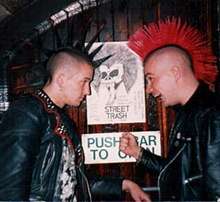
Punk politics cover the entire political spectrum. The punk ethos is primarily made up of beliefs such as non-conformity, anti-authoritarianism, anti-corporatism, a do-it-yourself ethic, anti-consumerist, anti-corporate greed, direct action and not "selling out".
There is a wide range of punk fashion, including deliberately offensive T-shirts, leather jackets, Dr. Martens boots, hairstyles such as brightly coloured hair and spiked mohawks, cosmetics, tattoos, jewellery and body modification. Women in the hardcore scene typically wore masculine clothing.[1]
Punk aesthetics determine the type of art punks enjoy, which typically has underground, minimalist, iconoclastic and satirical sensibilities. Punk has generated a considerable amount of poetry and prose, and has its own underground press in the form of zines. Many punk-themed films and videos have been made.
History
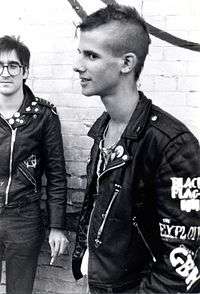
The punk subculture emerged in the United Kingdom and the United States in the mid-1970s. Exactly which region originated punk has long been a matter of controversy within the movement.[2][3][4][5][6][7][8] Early punk had an abundance of antecedents and influences, and Jon Savage describes the subculture as a "bricolage" of almost every previous youth culture in the Western world since World War II, "stuck together with safety pins".[9] Various musical, philosophical, political, literary and artistic movements influenced the subculture.
In the late 1970s, the subculture began to diversify, which led to the proliferation of factions such as new wave, post-punk, 2 Tone, pop punk, hardcore punk, no wave, street punk and Oi!. Hardcore punk, street punk and Oi! sought to do away with the frivolities introduced in the later years of the original punk movement.[10] The punk subculture influenced other underground music scenes such as alternative rock, indie music, crossover thrash and the extreme subgenres of heavy metal (mainly thrash metal, death metal, speed metal, and the NWOBHM).[10] A new movement in the United States became visible in the early and mid-1990s that sought to revive the punk movement, doing away with some of the trappings of hardcore.
Music
.jpg)
The punk subculture is centered on a loud, aggressive genre of rock music called punk rock, usually played by bands consisting of a vocalist, one or two electric guitarists, an electric bassist and a drummer. In some bands, the musicians contribute backup vocals, which typically consist of shouted slogans, choruses or football-style chants.
While most punk rock uses the distorted guitars and noisy drumming sounds derived from 1960s garage rock and 1970s pub rock, some punk bands incorporate elements from other subgenres, such as surf rock, rockabilly or reggae. Most punk rock songs are short, have simple and somewhat basic arrangements using relatively few chords, and they typically have lyrics that express punk ideologies and values, although some punk lyrics are about lighter topics such as partying or romantic relationships.
Different punk subcultures often distinguish themselves by having a unique style of punk rock, although not every style of punk rock has its own associated subculture.
The earliest form of music to be called "punk rock" was 1960s garage rock, and the term was applied to the genre retroactively by influential rock critics in the early 1970s.[11][12][13] In the late 1960s, music now referred to as protopunk originated as a garage rock revival in the northeastern United States.[14] The first distinct music scene to claim the punk label appeared in New York City between 1974 and 1976.[15] Around the same time or soon afterward, a punk scene developed in London.[16] Los Angeles subsequently became home to the third major punk scene.[17] These three cities formed the backbone of the burgeoning movement, but there were also other punk scenes in cities such as Brisbane, Melbourne and Sydney in Australia, Vancouver and Montreal in Canada, and Boston and San Francisco in the United States.
The punk subculture advocates a do-it-yourself (DIY) ethic. During the subculture's infancy members were almost all from a lower economic class, and had become tired of the affluence that was associated with popular rock music at the time. Punks would publish their own music or sign with small independent labels, in hopes to combat what they saw as a money hungry music industry. The DIY ethic is still popular with punks.
The New York City punk rock scene arose from a subcultural underground promoted by artists, reporters, musicians and a wide variety of non-mainstream enthusiasts. The Velvet Underground's harsh and experimental yet often melodic sound in the mid to late-1960s, much of it relating to transgressive media work by visual artist Andy Warhol, is credited for influencing 1970s bands such as the New York Dolls, The Stooges and the Ramones.[18] Early New York City punk bands were often short-lived, in part due to widespread use of recreational drugs, promiscuous sex, and sometimes violent power struggles, but the relative popularity of the music led to the evolution of punk into a movement and lifestyle.
Ideologies
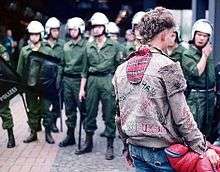
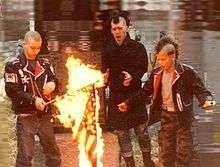
Although punks are frequently categorised as having left-wing, revolutionary, anarchist or progressive views, punk political ideology covers the entire political spectrum. Punk-related ideologies are mostly concerned with individual freedom and anti-establishment views. Common punk viewpoints include individual liberty, anti-authoritarianism, a DIY ethic, non-conformity, anti-collectivism, anti-corporatism, anti-government, direct action and not "selling out".
Some individuals within the punk subculture hold right-wing views (such as those associated with the Conservative Punk website), libertarian views, neo-Nazi views (Nazi punk), or are apolitical (e.g., horror punk).
Early British punks expressed nihilistic and anarchist views with the slogan No Future, which came from the Sex Pistols song "God Save the Queen". In the United States, punks had a different approach to nihilism which was less anarchistic than the British punks.[19] Punk nihilism was expressed in the use of "harder, more self-destructive, consciousness-obliterating substances like heroin, or methamphetamine"[20]
The issue of authenticity is important in the punk subculture—the pejorative term "poseur" is applied to those who associate with punk and adopt its stylistic attributes but are deemed not to share or understand the underlying values or philosophy.
Fashion
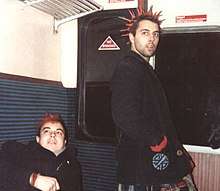
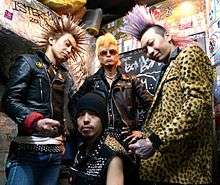
Early punk fashion adapted everyday objects for aesthetic effect: ripped clothing was held together by safety pins or wrapped with tape; ordinary clothing was customised by embellishing it with marker or adorning it with paint; a black bin liner became a dress, shirt or skirt; safety pins and razor blades were used as jewellery. Also popular have been leather, rubber, and PVC clothing that is often associated with transgressive sexuality, like BDSM and S&M.[21] A designer associated with early UK punk fashion was Vivienne Westwood, who made clothes for Malcolm McLaren's boutique in the King's Road, which became famous as "SEX".
Many punks wear tight "drainpipe" jeans, plaid/tartan trousers, kilts or skirts, T-shirts, leather jackets (often decorated with painted band logos, pins and buttons, and metal studs or spikes), and footwear such as high-cut Chuck Taylors, trainers, skate shoes, brothel creepers, Dr. Martens boots, and army boots. Early punks occasionally wore clothes displaying a swastika for shock value, but most contemporary punks are staunchly anti-racist and are more likely to wear a crossed-out swastika symbol than a pro-Nazi symbol. Some punks cut their hair into Mohawks or other dramatic shapes, style it to stand in spikes, and colour it with vibrant, unnatural hues.
Some punks are anti-fashion, arguing that punk should be defined by music or ideology. This is most common in the post-1980s US hardcore punk scene, where members of the subculture often dressed in plain T-shirts and jeans, rather than the more elaborate outfits and spiked, dyed hair of their British counterparts. Many groups adopt a look based on street clothes and working class outfits. Hardcore punk fans adopted a dressed-down style of T-shirts, jeans, combat boots or trainers and crewcuts. Women in the hardcore scene typically wore army trousers, band T-shirts, and hooded jumpers.[1]
The style of the 1980s hardcore scene contrasted with the more provocative fashion styles of late 1970s punk rockers (elaborate hairdos, torn clothes, patches, safety pins, studs, spikes, etc.). Circle Jerks frontman Keith Morris described early hardcore fashion as "the...punk scene was basically based on English fashion. But we had nothing to do with that. Black Flag and the Circle Jerks were so far from that. We looked like the kid who worked at the gas station or submarine shop."[22] Henry Rollins echoes Morris' point, stating that for him getting dressed up meant putting on a black shirt and some dark pants; Rollins viewed an interest in fashion as being a distraction.[23] Jimmy Gestapo from Murphy's Law describes his own transition from dressing in a punk style (spiked hair and a bondage belt) to adopting a hardcore style (i.e. boots and a shaved head) as being based on a need for more functional clothing.[1] A punk scholar states that "hardcore kids do not look like punks", since hardcore scene members wore basic clothing and short haircuts, in contrast to the "embellished leather jackets and pants" worn in the punk scene.[24]
In contrast to Morris' and Rollins' views, another punk scholar claims that the standard hardcore punk clothing and styles included torn jeans, leather jackets, spiked armbands and dog collars, mohawk hairstyles, and DIY ornamentation of clothes with studs, painted band names, political statements, and patches.[25] Yet another punk scholar describes the look that was common in the San Francisco hardcore scene as consisting of biker-style leather jackets, chains, studded wristbands, pierced noses and multiple piercings, painted or tattooed statements (e.g. an anarchy symbol) and hairstyles ranging from military-style haircuts dyed black or blonde, to mohawks and shaved heads.[26]
The Metropolitan Museum of Art in 2013 hosted a comprehensive exhibit, PUNK: Chaos to Couture, that examined the techniques of hardware, distress, and re-purposing in punk fashion.[27]
Gender and gender expression
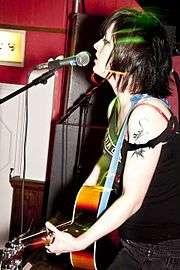
In the United Kingdom, the advent of punk in the late 1970s with its "anyone can do it" ethos led to women making significant contributions.[28][29] In contrast to the rock music and heavy metal scenes of the 1970s, which were dominated by men, the anarchic, counter-cultural mindset of the punk scene in mid- and late 1970s encouraged women to participate. "That was the beauty of the punk thing," Chrissie Hynde later said." [Sexual] discrimination didn't exist in that scene."[30] This participation played a role in the historical development of punk music, especially in the U.S. and U.K. at that time, and continues to influence and enable future generations.[31]
Rock historian Helen Reddington states that the popular image of young punk women musicians as focused on the fashion aspects of the scene (fishnet stockings, spiky blond hair, etc.) was stereotypical. She states that many, if not most women punks were more interested in the ideology and socio-political implications, rather than the fashion.[32][33] Music historian Caroline Coon contends that before punk, women in rock music were virtually invisible; in contrast, in punk, she argues "[i]t would be possible to write the whole history of punk music without mentioning any male bands at all – and I think a lot of [people] would find that very surprising."[34][35] Johnny Rotten wrote that ‘During the Pistols era, women were out there playing with the men, taking us on in equal terms ... It wasn’t combative, but compatible.’[36] Women were involved in bands such as The Runaways, The Slits, The Raincoats, Mo-dettes, and Dolly Mixture, The Innocents.
Others take issue with the notion of equal recognition, such as guitarist Viv Albertine, who stated that "the A&R men, the bouncers, the sound mixers, no one took us seriously.. So, no, we got no respect anywhere we went. People just didn't want us around."[37][38] The anti-establishment stance of punk opened the space for women who were treated like outsiders in a male-dominated industry. Sonic Youth's Kim Gordon states, "I think women are natural anarchists, because you're always operating in a male framework."[39]
Body and appearance
For some punks, the body was a symbol of opposition, a political statement expressing disgust of all that was "normal" and socially accepted.[40] The idea was to make others outside of the subculture question their own views, which made gender, gender presentation and gender identity a popular factor to be played with. Men could look like women, women could look like men, or one could look like both or neither. In some ways, punk helped to tear apart the normalised view of gender as a dichotomy. There was a notable amount of cross-dressing in the punk scene; it was not unusual to see men wearing ripped-up skirts, fishnet tights and excessive makeup, or to see women with shaved heads wearing oversized plaid shirts and jean jackets and heavy combat boots.[41] Punk created a new cultural space for androgyny and all kinds of gender expression.[42]
Some scholars have claimed that punk has been problematic towards gender by stating its overall resistance to expressing any kind of popular conceptions of femininity. In trying to reject societal norms, punk embraced one societal norm by deciding that strength and anger was best expressed through masculinity, defining masculine as the "default" in the world they were trying to create, where gender did not exist or had no meaning.[43] However, the main reasoning behind this argument equates femininity with popular conceptions of beauty, which punk rejected.
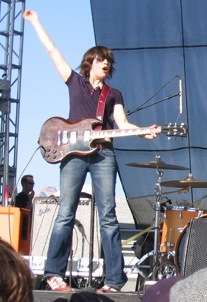
One part of punk was a creating explicitly outward identities of sexuality. Everything that was normally supposed to be hidden was brought to the front, both literally and figuratively. This could mean anything from wearing bras and underwear on top of clothing to wearing nothing but a bra and underwear. Although that act would seem sexualised in a normal context, to punks it was just another way to be obscene in the eyes of "others".[43] Punk seemed to allow women to sexualize themselves and still be taken seriously; however, many argue that this was always in terms of what the male punks wanted.[43]
Conversely, the masculine nature of punk allowed many women to recreate an almost farcical masculinity by using their female bodies in the same way men tended to use theirs. Punk women could be filthy and horrible and use their femininity to make what they were doing even more shocking to their audience. It became popular for some punk women to accentuate their bodies in ridiculous ways, such as stuffing their pants to make exaggerated labia outlines, as if parodying male crotch stuffing.[44] At one concert, Donita Sparks, lead singer of the band L7, pulled out her tampon and threw it into the audience. In many ways, female punks were showing unapologetically (and exaggeratedly) what it truly meant to be a woman, with nothing soft or "classically feminine" to hide behind.[43]
Riot grrrl
Riot grrrl is an underground feminist hardcore punk movement that originated in Washington, D.C. in the early 1990s,[45] and the Pacific Northwest, especially Olympia, Washington.[46] It is often associated with third-wave feminism, which is sometimes seen as its starting point. It has also been described as a musical genre that came out of indie rock, with the punk scene serving as an inspiration for a musical movement in which women could express themselves in the same way men had been doing for the past several years.[47]
Visual art
Punk aesthetics determine the type of art punks enjoy, usually with underground, minimalistic, iconoclastic and satirical sensibilities. Punk artwork graces album covers, flyers for concerts, and punk zines. Usually straightforward with clear messages, punk art is often concerned with political issues such as social injustice and economic disparity. The use of images of suffering to shock and create feelings of empathy in the viewer is common. Alternatively, punk artwork may contain images of selfishness, stupidity, or apathy to provoke contempt in the viewer.
Much of the earlier artwork was black and white, because it was distributed in zines reproduced by photocopying at work, school or at copy shops. Punk art also uses the mass production aesthetic of Andy Warhol's Factory studio. Punk played a hand in the revival of stencil art, spearheaded by Crass. The Situationists also influenced the look of punk art, particularity that of the Sex Pistols created by Jamie Reid. Punk art often utilises collage, exemplified by the art of Jamie Reid, Crass, The Clash, Dead Kennedys,and Winston Smith. John Holmstrom was a punk cartoonist who created work for the Ramones and Punk.
The Stuckism art movement had its origin in punk, and titled its first major show The Stuckists Punk Victorian at the Walker Art Gallery during the 2004 Liverpool Biennial. Charles Thomson, co-founder of the group, described punk as "a major breakthrough" in his art.[48]
Dance
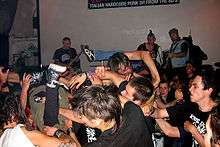
Two dance styles associated with punk are pogo dancing and moshing.[49] The pogo is a dance in which the dancers jump up and down, while either remaining on the spot or moving around; the dance takes its name from its resemblance to the use of a pogo stick, especially in a common version of the dance, where an individual keeps their torso stiff, their arms rigid, and their legs close together. Pogo dancing is closely associated with punk rock and is a precursor to moshing. Moshing or slamdancing is a style of dance where participants push or slam into each other, typically during a live music show. It is usually associated with "aggressive" music genres, such as hardcore punk and thrash metal. Stage diving and crowd surfing were originally associated with protopunk bands such as The Stooges, and have appeared at punk, metal and rock concerts. Ska punk promoted an updated version of skanking. Hardcore dancing is a later development influenced by all of the above-mentioned styles. Psychobillies prefer to "wreck", a form of slam dancing that involves people punching each other in the chest and arms as they move around the circle pit.
Literature
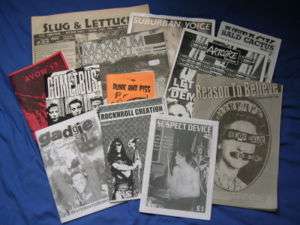
Punk has generated a considerable amount of poetry and prose. Punk has its own underground press in the form of punk zines, which feature news, gossip, cultural criticism, and interviews. Some zines take the form of perzines. Important punk zines include Maximum RocknRoll, Punk Planet, No Cure, Cometbus, Flipside, and Search & Destroy. Several novels, biographies, autobiographies, and comic books have been written about punk. Love and Rockets is a comic with a plot involving the Los Angeles punk scene.
Just as zines played an important role in spreading information in the punk era (e.g. British fanzines like Mark Perry's Sniffin Glue and Shane MacGowan's Bondage), zines also played an important role in the hardcore scene. In the pre-Internet era, zines enabled readers to learn about bands, shows, clubs, and record labels. Zines typically included reviews of shows and records, interviews with bands, letters to the editor, and advertisements for records and labels. Zines were DIY products, "proudly amateur, usually handmade, and always independent", and during the "’90s, zines were the primary way to stay up on punk and hardcore."[50] They were the "blogs, comment sections, and social networks of their day."[50]
In the American Midwest, the zine Touch and Go described the regional hardcore scene from 1979 to 1983.[51] We Got Power described the LA scene from 1981 to 1984, and included show reviews of and interviews with such bands as Vancouver's D.O.A., the Misfits, Black Flag, Suicidal Tendencies and the Circle Jerks.[52] My Rules was a photo zine that included photos of hardcore shows from across the US. In Effect, which began in 1988, described the New York City scene.[53]
Punk poets include: Richard Hell, Jim Carroll, Patti Smith, John Cooper Clarke, Seething Wells, Raegan Butcher, and Attila the Stockbroker. The Medway Poets performance group included punk musician Billy Childish and had an influence on Tracey Emin. Jim Carroll's autobiographical works are among the first known examples of punk literature. The punk subculture has inspired the cyberpunk and steampunk literature genres, and has even contributed (through Iggy Pop) to classical scholarship.[54]
Film
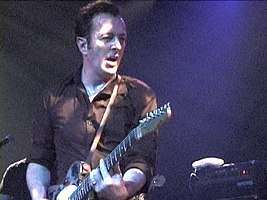
Many punk-themed films have been made. The No Wave Cinema and Remodernist film movements owe much to punk aesthetics. Several famous punk bands have participated in movies, such as the Ramones in Rock 'n' Roll High School, the Sex Pistols in The Great Rock 'n' Roll Swindle and Social Distortion in Another State of Mind. Derek Jarman and Don Letts are notable punk filmmakers. Penelope Spheeris' first instalment of the documentary trilogy "The Decline of Western Civilization" (1981) focuses on the early Los Angeles punk scene through interviews and early concert footage from bands including Black Flag, Circle Jerks, Germs and Fear. The Decline of Western Civilization III" explores the gutter punk lifestyle in the 1990s. Loren Cass is another example of the punk subculture represented in film.[55] Also, the documentary film AfroPunk covers the black experience in the punk DIY scene.[56]
More Films/Documentaries: Suburbia Bomb City Punks In Prague The Green Room Summer Of Sam Sid And Nancy CBGB SLC Punks
Perspectives on drugs and alcohol
Inhalable solvents
"[Glue] sniffing was adopted by punks because public perceptions of sniffing fitted in with their self-image. Originally used experimentally and as a cheap high, adult disgust and hostility encouraged punks to use glue sniffing as a way of shocking society."[57] Model airplane glue and contact cement were among the numerous solvents and inhalants used by punks to achieve euphoria and intoxication. Glue was typically inhaled by placing a quantity in a plastic bag and "huffing" (inhaling) the vapour. Liquid solvents were typically inhaled by soaking a rag with the solvent and inhaling the vapour. While users inhale solvents for the intoxicating effects, the practice can be harmful or fatal.
Straight edge
Straight edge is a philosophy of hardcore punk culture, adherents of which refrain from using alcohol, tobacco, and other recreational drugs, in reaction to the excesses of punk subculture.[58][59] For some, this extends to refraining from engaging in promiscuous sex, following a vegetarian or vegan diet, and not drinking coffee or taking prescribed medicine.[58] The term straight edge was adopted from the 1981 song "Straight Edge" by the hardcore punk band Minor Threat.[60]
Straight edge emerged amid the early-1980s hardcore punk scene. Since then, a wide variety of beliefs and ideas have been associated with the movement, including vegetarianism and animal rights.[61][62] Ross Haenfler writes that as of the late 1990s, approximately three out of four straight edge participants were vegetarian or vegan.[63] While the commonly expressed aspects of the straight edge subculture have been abstinence from alcohol, nicotine, and illegal drugs, there have been considerable variations on how far to take the interpretations of "abstaining from intoxicants" or "living drug-free". Disagreements often arise as to the primary reasons for living straight edge. Straight edge politics are primarily left-wing and revolutionary but there have been conservative offshoots.[64]
In 1999, William Tsitsos wrote that straight edge had gone through three eras since its founding in the early 1980s.[65] Bent edge began as a counter-movement to straight edge by members of the Washington, D.C. hardcore scene who were frustrated by the rigidity and intolerance in the scene.[66] During the youth crew era, which started in the mid-1980s, the influence of music on the straight edge scene was at an all-time high. By the early 1990s, militant straight edge was a well-known part of the wider punk scene. In the early to mid-1990s, straight edge spread from the United States to Northern Europe,[67] Eastern Europe,[68] the Middle East,[69] and South America.[70] By the beginning of the 2000s, militant straight edge punks had largely left the broader straight edge culture and movement.[71]
Lifestyle and community
.jpg)
Punks come from all culture and economic classes. Compared to some subcultures, punk ideology is much closer to gender equality. Although the punk subculture is mostly anti-racist, it is overwhelmingly white.[72] However, members of other groups (such as African Americans, other black people, Latinos, and Asians) have contributed to the development of the subculture.[72] Substance abuse has sometimes been a part of the punk scene, with the notable exception of the straight edge movement. Violence has also sometimes appeared in the punk subculture, but has been opposed by some subsets of the subculture, such as the pacifist strain anarcho-punk.[73]
.jpg)
Punks often form a local scene, which can have as few as half a dozen members in a small town, or as many as thousands of in a major city.[74] A local scene usually has a small group of dedicated punks surrounded by a more casual periphery. A typical punk scene is made up of punk and hardcore bands, fans who attend concerts, protests, and other events, zine publishers, reviewers, and other writers, visual artists illustrating zines, and creating posters and album covers, show promoters, and people who work at music venues or independent record labels.[74]
Squatting plays a role in many punk communities, providing shelter and other forms of support. Squats in abandoned or condemned housing, and communal "punk houses" often provide bands a place to stay while they are touring. There are some punk communes, such as Essex's Dial House. The Internet has been playing an increasingly large role in punk, specifically in the form of virtual communities and file sharing programs for trading music files.[75]
Authenticity
In the punk and hardcore subcultures, members of the scene are often evaluated in terms of the authenticity of their commitment to the values or philosophies of the scene, which may range from political beliefs to lifestyle practices. In the punk subculture, the epithet poseur (or "poser") is used to describe "a person who habitually pretends to be something [they are] not." The term is used to refer to a person who adopts the dress, speech, and/or mannerisms of a particular subculture, yet who is deemed to not share or understand the values or philosophy of the subculture.[76][77][78]
While this perceived inauthenticity is viewed with scorn and contempt by members of the subculture, the definition of the term and to whom it should be applied is subjective. An article in Drowned in Sound argues that 1980s-era "hardcore is the true spirit of punk", because "after all the poseurs and fashionistas [moved on] to the next trend of skinny pink ties with New Romantic haircuts, singing wimpy lyrics", the punk scene consisted only of people "completely dedicated to the DIY ethics".[79]
In the discussion of authenticity it is necessary to recognize the origins of punk music. Proto-punk bands came out of garage-rock during the late 1960s. Usually white working-class boys are credited for pioneering the genre, however there were many women and people of color who contributed to the original punk sound and aesthetic. Because the original subculture meant to challenge everything about the mainstream, usually in shocking ways, the "punk" that people usually picture became inauthentic once it was brought to the mainstream; "‘Inauthentic’ punk is a commercialized and debased form of an original ‘street’ form of punk"(Sabin, 1999). This is the paradox of punk; as a subculture it must always be evolving in order to stay out of the mainstream.
Punk Girls written by Liz Ham is a photo-book featuring 100 portraits of Australian women in the punk subculture, and it was published in 2017 by Manuscript Daily.[80][81][82][83][84] Discrimination against punk subculture is explored with her photographs in the book; these girls who are not mainstream, but "beautiful and talented".[85]
Interactions with other subcultures
Glam rockers such as T.Rex, the New York Dolls and David Bowie had big influences on protopunk, early punk rock, and the crossover subgenre later called glam punk. Particularly, David Bowie himself supported the neophyte punk bands of this time, and he later said after punk somewhat fell out of fashion, "I think it's a crying shame that the category has dissipated its importance."[86] Punk and hip hop emerged around the same time in the late 1970s New York City, and there has been some interaction between the two subcultures. Some of the first hip hop MCs called themselves punk rockers, and some punk fashions have found their way into hip hop dress and vice versa. Malcolm McLaren played roles in introducing both punk and hip hop to the United Kingdom. Hip hop later influenced some punk and hardcore bands, such as Hed PE, Blaggers I.T.A., Biohazard, E.Town Concrete, The Transplants and Refused.[87]
The skinhead subculture of the United Kingdom in the late 1960s – which had almost disappeared in the early 1970s — was revived in the late 1970s, partly because of the influence of punk rock, especially the Oi! punk subgenre. Conversely, ska and reggae, popular among traditionalist skinheads, has influenced several punk musicians. Punks and skinheads have had both antagonistic and friendly relationships, depending on the social circumstances, time period and geographic location.[88]
The punk and heavy metal subcultures have shared some similarities since punk's inception. The early 1970s protopunk scene had an influence on the development of heavy metal. Alice Cooper was a forerunner of the fashion and music of both the punk and metal subcultures. Motörhead, since their first album release in 1977, have enjoyed continued popularity in the punk scene, and their now-deceased frontman Lemmy was a fan of punk rock. Genres such as metalcore, grindcore and crossover thrash were greatly influenced by punk rock and heavy metal. The new wave of British heavy metal influenced the UK 82-style of bands like Discharge, and hardcore was a primary influence on thrash metal bands such as Metallica and Slayer. The early 1990s grunge subculture was a fusion of punk anti-fashion ideals and metal-influenced guitar sounds. However, hardcore punk and grunge developed in part as reactions against the heavy metal music that was popular during the 1980s.[89]
In punk's heyday, punks faced harassment and attacks from the general public and from members of other subcultures. In the 1980s in the UK, punks were sometimes involved in brawls with Teddy Boys, greasers, bikers, mods and members of other subcultures. There was also considerable enmity between Positive punks (known today as goths) and the glamorously dressed New Romantics.
In the late 1970s, punks were known to have had confrontations with hippies due to the contrasting ideologies and backlash of the hippie culture.[90] Nevertheless, Penny Rimbaud of the English anarcho-punk band Crass said that Crass was formed in memory of his friend, the hippie Wally Hope.[91] Rimbaud also said that Crass were heavily involved with the hippie movement throughout the 1960s and 1970s, with Dial House being established in 1967. Many punks were often critical of Crass for their involvement in the hippie movement. Like Crass, Jello Biafra was influenced by the hippie movement and cited the yippies as a key influence on his political activism and thinking, though he did write songs critical of hippies.[73][92]
The industrial and rivethead subcultures have had several ties to punk, in terms of music, fashion and attitude.
Power pop music (as defined by groups such as Badfinger, Cheap Trick, The Knack, and The Romantics) emerged in mostly the same time-frame and geographical area as punk rock, and they shared a great deal musically in terms of playing short songs loud and fast while trying to emphasize catchy feelings. More melodic and pop-influenced punk music have also often been wrapped alongside power pop bands under the general "new wave music" label.[93] A good example of a genre-straddling 'power pop punk' band is the popular Northern Ireland group Protex.[94] However, stylistically and lyrically, power pop bands have tended to have a very "not-punk" top 40 commercial pop music influence and a flashier, heavily teen-pop sense of fashion, especially modern power pop groups such as Stereo Skyline and All Time Low.
Global perspectives
The punk subculture has spread to many countries around the world. The fluidity of musical expression in particular makes it an ideal medium for this cross-cultural interpretation.[95]
Mexico
In Mexico, punk culture is primarily a phenomenon among middle and lower class youth, many of whom were first exposed to punk music through travel to England.[96] Because of low fees at public universities in Mexico, a significant minority of Mexican punks are university students.[97] It is estimated approximately 5,000 young people are active punks in Mexico City, hosting two or three underground shows a week.[97] These young people often form chavos banda—youth gangs—that organise subculture activity by creating formal meeting spaces and rituals and practices.[98]
Oral nicknames are a distinguishing feature of Mexican punk, where the tradition of oral culture has influenced the development of nicknames for almost all Mexican punks. Patches are widely used as an inexpensive way to alter clothing and express identity. Though English language bands like the Dead Kennedys are well known in Mexico, punks there prefer Spanish-language music or covers translated into Spanish. The slam dance style common in the California punk scene of the early 1980s is in the 2010s very popular.[97]
Performance practices reflect socio-economic circumstances of Mexican punks. Called tocadas, shows are generally held in public spaces like basketball courts or community centers instead of places of business like bars and restaurants, as is more common in the United States and Europe. They usually take place in the afternoon and end early to accommodate the three or four hours it takes many punks to return home by public transit. Mexican punk groups rarely release vinyl or CD recordings, preferring cassettes.[97]
Though Mexican punk itself does not have an explicit political agenda, Mexican punks have been active in the Zapatista, Anarcho-punk,[96] and Anti-globalisation movements.[97]
Russia and the Soviet Union
The anti-establishment punk sub-culture has appealed to Russians for decades, with punk media, fashion, and albums becoming enormously popular underground items in the late 1970s onwards. Musically, the sound of punk rock became a clear protest against the disco influenced, heavily electronic official Soviet regime songs. The government suppressed punks and ruthlessly censored their music.
The founder of Russian punk is considered to be Yegor Letov with his band Grazhdanskaya Oborona, which started performing in the early 1980s. Letov also invented a word chanted by punk fans during concerts, Hoi (a mixture of the Oi! movement and the Russian profanity word Hui (literally penis)).
In the late 1980s Sektor Gaza formed, reaching cult status. They created a genre called "Kolkhoz punk", which mixed elements from village life into punk music. Another cult band which started a few years later was Korol i Shut, introducing horror punk, using costumes and lyrics in the form of tales and fables. Korol i Shut became one of the best selling and most highly regarded bands in the history of russian Rock.
More recent expressions of punk sub-culture in Russia have included the formation of the feminist protest punk rock group Pussy Riot, which formed in 2011. With lyrical themes including feminism, LGBT rights and opposition to Russian President Vladimir Putin, along with the playing of unauthorised guerilla performances, Pussy Riot has gained notoriety, which has led to the incarceration of some of the group's members. The trial and sentencing of Pussy Riot's members has led to significant criticism, particularly in the West, including by Amnesty International.
South Africa
Punk arrived slowly in South Africa during the 1970s when waves of British tradesman welcomed by the then-apartheid government brought cultural influences like the popular British music magazine NME,[99] sold in South Africa six weeks after publication.[99]
South African punk developed separately in Johannesburg, Durban, and Cape Town and relied on live performances in townships and streets as the multi-racial composition of bands and fan bases challenged the legal and social conventions of the apartheid regime.[99]
Political participation is foundational to punk subculture in South Africa. During the apartheid regime, punk was second only to Rock music in its importance to multi-racial interactions in South Africa.[99] Because of this, any involvement in the punk scene was in itself a political statement. Police harassment was common and the government often censored explicitly political lyrics. Johannesburg based band National Wake was routinely censored and even banned for songs like "International News," which challenged the South African government's refusal to acknowledge the racial and political conflict in the country.[100] National Wake guitarist Ivan Kadey attributes the punk scene's ability to persevere despite the legal challenges of multi-racial mixing to punk subculture's DIY ethic and anti-establishment attitude.[100]
In post-apartheid South Africa, punk has attracted a greater number of white middle-class males than the more diverse makeup of the subculture during the apartheid era. Thabo Mbeki's African Renaissance movement has complicated the position of white South Africans in contemporary society. Punk provides young white men the opportunity to explore and express their minority identity.[101] Cape Town band Hog Hoggidy Hog sings of the strange status of white Africans:
- It's my home it's where I'll stay and where I belong,
- I didn't choose to be here I was born I might seem out of place
- but everything I hold dear is under the African sun.[101]
Post-apartheid punk subculture continues to be active in South African politics, organising a 2000 festival called Punks Against Racism at Thrashers Statepark in Pretoria. Rather than the sense of despondency and fatalism that characterised 1970s British punk subculture, the politically engaged South African scene is more positive about the future of South Africa.[101]
Peru
In Peru punk traces its roots to the band Los Saicos, a Lima group that played the unique blend of garage and break dance music that would later be labeled punk as early as the 1960s. The early activity of Los Saicos has led many to claim that punk originated in Lima instead of the UK, as it typically assumed.[8] Though their claim to be the first punk band in the world can be disputed, Los Saicos were undoubtedly the first in Latin America and released their first single in 1965.[102][103] The group played to full houses and made frequent television appearances throughout the 1960s. Throughout the 1970s, the band was completely forgotten. Years later, a plaque that declares "here the global punk-rock movement was born" was placed at the corner of Miguel Iglesias and Julio C. Tello Streets in Lima.[104]
By the 1980s the punk scene in Peru was highly active. Peruvian punks call themselves subtes and appropriate the subversive implications of the English term "underground" through the Spanish term subterraneo (literally, subterranean).[105] In the 1980s and 1990s subtes made almost exclusive use of cassette recording as a means of circulating music without participating in formal intellectual property and musical production industries. The current scene relies on digital distribution and assumes similar anti-establishment practices.[105] Like many punk subcultures, subtes explicitly oppose the Peruvian state and advocate instead an anarchic resistance that challenges the political and mainstream cultural establishment.
Brazil
The origins of punk rock in Brazil go back to the late 1970s, as in most other countries mainly under the influence of the Sex Pistols, The Clash and The Ramones. However, particularly in São Paulo, more obscure names like Dutch band Speed Twins, as well as earlier protopunk artists such as MC5, The Stooges and The New York Dolls also had a big initial impact.
Brazilian punk emerged in part from the ideals of the musician Douglas Viscaino, who, imbued with the pioneering ideas and unity of young people that fought against the Brazilian military regime, formed a band of protest called: Restos de Nada (Remnants of Nothing). Their musicians already had their punk ideals before 1978.
Then came AI-5 and N.A.I. (later known as Condutores de Cadáver, "corpse riders") in São Paulo, as well as Carne Podre ("rotten flesh") in Curitiba (the capital of Paraná State), and Aborto Elétrico ("electric miscarriage") in Brasília (the national capital).
Before punk proper bands emerged, two relatively famous glam and hard rock bands, Joelho de Porco (literally "pig knee") and Made in Brazil, used elements of the punk aesthetic around 1977 or 1978, and were called punk bands by the media without really playing punk rock music or defining themselves as such. Both bands, however, were important to the pre-punk context of the 1970s that offered few alternatives to the Música popular brasileira (MPB) and progressive rock artists that dominated the Brazilian music scene at the time. Joelho de Porco's lyrics dealing with São Paulo's urban reality was also influential.
Indonesia
In the late 2000s, punk rock faced harsh criticism in Indonesia's province of Aceh. Punk rock is seen as a threat to Islamic values and, according to authorities, conflicts with Shariah law.[106]
Canada
The emergence of punk rock in Canada followed roughly the timelines of both the UK and the US, and was at first confined to Canada's largest cities. Since the mid-1980s, Canada's punk scene has spread over the entire country, including small rural towns and villages.
In 1978, Vancouver had a fledgling punk scene, with such bands as D.O.A., Pointed Sticks, and The Subhumans.
Edmonton's SNFU formed in 1981. They relocated to Vancouver in 1991 where, as of 2017, they were still active.
Gerry "Useless" Hannah of The Subhumans received a ten-year prison sentence (of which he served five years) for his involvement in the Direct Action urban guerrilla cell, also known as the Vancouver five and the Squamish five, which executed a series of attacks on civil infrastructure in BC and Ontario.
Cuba
A punk subculture originated in Cuba in the 1980s, referred to as Los Frikis.[107] As Cuban radio stations rarely played rock music, Frikis often listened to music by picking up radio frequencies from stations in nearby Florida.[108] While many Frikas in the early-1990s entered AIDS clinics by knowingly injecting HIV-positive blood into them, others began congregating at El patio de María, a community centre in Havana that was one of the few venues in the city that allowed rock bands to play.[100] Some Frikis also participate in squatting as an act of political defiance.[109]
In its beginning, the subculture was seen as a threat to the collectivism of Cuban society, leading to make Frikis becoming victims of discrimination and police brutality.[110] According to the New Times Broward-Palm Beach some Frikis were "rejected by family and often jailed or fined by the government",[111] the 1980s Friki woman Yoandra Cardoso however has that argued that much of the response was verbal harassment from law enforcement.[112] Dionisio Arce, lead vocalist of Cuban heavy metal band Zeus spent six years in prison due to his part in the Frikis.[113] Some schools would forcible shave the heads of young Frikis as a form of punishment.[108]
See also
| Wikimedia Commons has media related to Punk. |
- Punk fashion
- Punk rock
- Hardcore punk
- List of subcultures
- History of subcultures in the 20th century
- List of punk bands
- Punk rock subgenres
- List of hardcore punk subgenres
- Art punk
- Timeline of punk rock
- Hooliganism
References
- "Not Just Boys' Fun?" (PDF). Duo.uio.no. p. 11. Retrieved 20 May 2014.
- Marsh, Dave (May 1971). "Will Success Spoil The Fruit?". Creem magazine. Archived from the original on 12 February 2007. Retrieved 19 November 2006.
- Moore, Thurston (1996). "Grabbing Ankles". Bomb Magazine. Retrieved 19 November 2006.
- Robb, John (5 November 2005). "The birth of punk". The Independent. London. Archived from the original on 27 April 2006. Retrieved 17 December 2006.
- Savage, Jon. England's Dreaming: The Sex Pistols and Punk Rock. Faber and Faber, 1991. ISBN 0-312-28822-0
- Australian Broadcasting Corporation (2 October 2003). "Misfits and Malcontents". Australia: ABC. Retrieved 1 November 2006.
- Dougan, John. "The Saints: Biography". Billboard. Retrieved 1 November 2006.
- Watts, Johnanathan (14 September 2012). "Where did punk begin? A cinema in Peru". The Guardian. Retrieved 9 May 2013.
- Savage, Jon. Teenage: The Creation of Youth Culture. P. xvi. 2007. Viking. England.
- AllMusic, . Retrieved 18 April 2009.
- Bangs, Lester. Psychotic Reactions and Carburetor Dung. Anchor Books, a division of Random House. 2003. pg. 8, 56, 57, 61, 64, 101: reprints of articles which appeared in 1971 and 1972, that refer to garage bands such as the Count Five and the Troggs as "punk"; pg. 101 associates "Iggy" and "Jonathan of Modern Lovers" with the Troggs and their ilk (as being punk); pg. 112-113 speak of the Guess Who as "punk"--The Guess Who had made recordings (i.e. their hit version of Shakin' All Over," 1965) as a garage rock outfit in the mid 60s; pg. 8 makes a general statement about "punk rock" (garage) as a genre: "...then punk bands started cropping up who were writing their own songs but taking the Yardbirds' sound and reducing it to this kind of goony fuzztone clatter...oh, it was beautiful, it was pure folklore, Old America, and sometimes I think those were the best days ever."; pg. 225 is a reprint from article which appeared in late-70s, that refers back to garage bands as "punk"
- Laing, Dave. One Chord Wonders: Power and Meaning in Punk Rock. PM Press. Oakland, CA 2015, 1984. pg. 22-23 - Laing writes that the term, "punk rock" was used "generically" (i.e. as to designate a genre) in the early 70s to describe mid-60s garage rock bands—he quotes Greg Shaw from the late 70s referring to how it was used in the early 70s to designate the genre: "Punk rock in those days was a quaint fanzine term for a transient form of mid-60s music..." Archived 27 July 2015 at the Wayback Machine >Marsh, D. Creem. May, 1971--from a review of live show by ? & the Mysterions - Marsh refers to their style as "a landmark exposition of punk rock."; >Christgau, Robert. Village Voice. October, 1971 - refers to "mid-60's garage rock as "punk" >Shaw, Greg. Who Put the Bomp. 1971. - In 1971 article in Who Put the Bomp, Greg Shaw wrote about "...what I have chosen to call 'punk rock' bands—white teenage hard rock of '64-66 (Standells, Kingsmen, Shadows of Knight, etc.)"
- Kaye, Lenny. "Headed, Decked, and Stroked..."--original liner notes for Nuggets LP. (Elektra, 1972): uses the term "punk rock" to describe whole genre of 60s garage bands: "..the name that has been unofficially coined for them - "punk rock" - seems particularly fitting in this case..." >Shaw, Greg. Rolling Stone, Jan. 4, 1973 - review of original Nuggets LP: speaks of whole phenomenon of 60s garage bands as an actual genre called "punk rock": "Punk rock at its best is the closest we came in the 60's to the original rockabilly spirit of Rock 'n Roll..."
- "Protopunk" from Allmusic.com
- Harrington, Joe S. Sonic Cool: The Life & Death of Rock 'N' Roll. pp. 324–30. 2002. Hal-Leonard. USA.
- Harrington, Joe S. Sonic Cool: The Life & Death of Rock 'N' Roll. pp. 344–50. 2002. Hal-Leonard. USA.
- AllMusic, Punk. Retrieved 18 April 2009.
- Please Kill Me: The Uncensored Oral History of Punk. Grove Press. 2006. ISBN 978-0-8021-4264-1.
- Stratton, Jon (January 2005). "Jews, Punk and the Holocaust: From the Velvet Underground to the Ramones: The Jewish-American Story". Popular Music. Cambridge University Press. 24 (1): 79–105. doi:10.1017/S0261143004000315. hdl:20.500.11937/17488. JSTOR 3877595.
- "The Situationist International Text Library/Consumer Society and Authenticity". Library.nothingness.org. 3 October 1995. Retrieved 12 February 2010.
- Walker, John. (1992) "Punk". Glossary of Art, Architecture & Design since 1945, 3rd. ed.
- "CITIZINE Interview - Circle Jerks' Keith Morris (Black Flag, Diabetes)". Citizinemag.com. 17 February 2003. Archived from the original on 6 October 2011. Retrieved 4 December 2011.
- "Hardcore punk of the '80s preferred simple, utilitarian style because it was better for moshing. — 29 Things You Didn't Know About Punk Style | Complex". M.complex.com. Retrieved 20 May 2014.
- "Not Just Boys' Fun?" (PDF). Duo.uio.no. p. 12. Retrieved 20 May 2014.
- Lauraine Leblanc. Pretty in Punk: Girls' Gender Resistance in a Boys' Subculture. Rutgers University Press, 1999. P. 52
- Skinheads: A Guide to an American Subculture. By Tiffini A. Travis, Perry Hardy. ABC-CLIO, 2012. P. 123 (section entitled "From San Francisco Hardcore Punks to Skinheads")
- "Punk: Chaos to Couture fashion design, indie clothing, style, beauty". Ms. Fabulous. 7 May 2013. Retrieved 20 May 2014.
- Coon, Caroline (1977). 1988: The New Wave Punk Rock Explosion. London: Omnibus/Hawthorne Books. ISBN 978-0801561290.
- Berman, Judy (8 August 2011). "15 Essential Women Punk Rock Icons". Flavorwire. Retrieved 25 November 2015.
- "Women of Punk and Post-Punk Music". Biography.com. Retrieved 26 November 2015.
- "Why Women in Punk?". Punk77.co.uk. Retrieved 26 November 2015.
- Reddington, Helen (2012). The Lost Women of Rock Music: Female Musicians of the Punk Era. Ashgate/Equinox Publishing. ISBN 978-1845539573. Archived from the original on 27 November 2015. Retrieved 26 November 2015.
- Woronzoff, Elizabeth. "The Lost Women of Rock Music' Is an Important Work, But a Replay of the Same Old Themes". Pop Matters. Retrieved 26 November 2015.
- Conference proceedings (September 2001). "No Future?". University of Wolverhampton.
- Reddington, Helen (1977). Introduction: The Lost Women of Rock Music (PDF). London: Ashgate. ISBN 9780754657736. Archived from the original (PDF) on 7 December 2015. Retrieved 16 March 2016.
- Lydon, John (1995). Rotten: No Irish, No Blacks, No Dogs. London: Coronet. p. 378. ISBN 978-0312428136.
- Petridis, Alexis. "The Slits' Viv Albertine on punk, violence and doomed domesticity". The Guardian. Retrieved 27 November 2015.
- Andrews, Charlotte Richardson (3 July 2014). "Punk has a problem with women. Why?". The Guardian. Retrieved 27 November 2015.
- Hall, Rock. "Women Who Rock: 10 Essential Punk Songs". The Rock & Roll Hall of Fame Museum. Retrieved 27 November 2015.
- Dale, Pete (2012). Anyone Can Do It: Empowerment, Tradition and the Punk Underground. Ashgate Publishing Limited.
- Suterwalla, Shehnaz (2013). "Cut, Layer, Break, Fold: Fashioning Gendered Difference, 1970s to the Present". WSQ: Women's Studies Quarterly. 41 (1–2): 267–284. doi:10.1353/wsq.2013.0047.
- Young, Tricia Henry (1998). Break All Rules! Punk Rock and the Making of a Style. UMI Research Press. ISBN 978-0-8357-1980-3.
- LeBlanc, Lauraine (1999). Pretty in Punk: Girls' Gender Resistance in a Boys' Subculture. Rutgers University Press. ISBN 978-0-8135-2651-5.
- Stewart, Francis (25 May 2017). Punk Rock is My Religion: Straight Edge Punk and 'Religious' Identity. Taylor & Francis. ISBN 9781351725569.
- "Boston wins 'Most Feminist City' with Riot Grrrl Day — we made a playlist to celebrate". sheknows.com. 9 April 2015.
- Feliciano, Steve. "The Riot Grrrl Movement". New York Public Library.
- Marion Leonard. "Riot grrrl." Grove Music Online. Oxford Music Online. Oxford University Press. Web. 20 July 2014.
- "Modern Art Blog » Blog Archive » Interview with Charles Thomson of the Stuckists". Artistica. 29 January 2006. Archived from the original on 9 October 2009. Retrieved 12 February 2010.
- "A Metaphysics of the Mosh Pit". PopMatters. Retrieved 12 February 2010.
- Heller, Jason (15 October 2013). "With zines, the '90s punk scene had a living history · Fear Of A Punk Decade". The A.V. Club. Archived from the original on 1 November 2013. Retrieved 20 May 2014.
- "Touch and Go: The Complete Hardcore Punk Zine '79-'83". Skyscraper Magazine. Archived from the original on 3 November 2013. Retrieved 20 May 2014.
- Margasak, Peter (19 March 2013). "80s punk zine We Got Power! still packs a punch | Bleader | Chicago". M.chicagoreader.com. Retrieved 20 May 2014.
- "About". InEffectHardcore.com. 16 May 2014. Retrieved 20 May 2014.
- "Archived copy". Archived from the original on 22 October 2015. Retrieved 15 October 2015.CS1 maint: archived copy as title (link)
- "Loren Cass". IMDb.com. Retrieved 10 July 2020.
- "The True Story Of How Afropunk Turned A Message Board Into A Movement". Thefader.com. Retrieved 10 July 2020.
- "PCP, Quaaludes, Mescaline. What Became of Yesterday's "It" Drugs? - The Fix". thefix.com. 30 December 2011.
- Sutherland, Sam (July 2006). "The Complicated Contradictions of Straight Edge Punk". Exclaim!. Retrieved 22 February 2010.
- Krist, Josh (22 August 1996). "White Punks on Hope". Phoenix New Times. Retrieved 22 February 2010.
- Cogan 2008, p. 317
- Wood 1999, pp. 130–40
- Wood 1999, pp. 141–43
- Haenfler 2004, pp. 427
- Kuhn, Gabriel (2009). Sober Living for the Revolution. PM Press. pp. 13–14.
- Tsitsos 1999, pp. 397-414
- Andersen 2003, p. 125
- Kuhn 2010, p. 121
- Kuhn 2010, p. 132
- Kuhn 2010, p. 112
- Kuhn 2010, p. 66
- Haenfler 2006, pp. 16–17
- Traber, Daniel S. (2001). "L. A.'s "White Minority": Punk and the Contradictions of Self-Marginalization". Cultural Critique. 48 (Spring): 30–64. doi:10.1353/cul.2001.0040. JSTOR 1354396.
- Sabin, Roger (1999). Punk rock, so what? : the cultural legacy of punk. London New York: Routledge. ISBN 978-0-415-17030-7.
- Grossman, Perry (2002). "Punk". St. James Encyclopaedia of Popular Culture. Archived from the original on 17 May 2007. Retrieved 27 December 2006.
- Hara, Craig (1999). The philosophy of punk : more than noise. Edinburgh: AK. ISBN 978-1-873176-16-0.
- O'Hara, Craig (1999). The Philosophy of Punk. San Francisco: AK Press. ISBN 978-1-873176-16-0.
- Marsh, Dave (June 1995). "LIVE THROUGH THIS..." Rock & Rap Archives. 124. Archived from the original on 14 January 2012. Retrieved 12 November 2011.
- "The Orphans Story". Perthpunk.com. 15 August 1978. Archived from the original on 2 October 2009. Retrieved 12 February 2010.
- Symonds, Rene (16 August 2007). "Features – Soul Brothers: DiS meets Bad Brains". Drowned in Sound. Retrieved 12 February 2010.
- Ham, Liz (November 2017). Punk Girls. Manuscript Publishing. ISBN 978-0-648-05981-3.
- "PUNK GIRLS". manuscriptdaily. 6 November 2017.
- "Punk Girls: taking fetishism out of the subculture". Australian Broadcasting Company. 10 June 2016.
- Kubler, Alison. "Liz Ham Punk Girls". Vault Australasian Art & Culture.
- ""PUNK GIRLS" Book to Be Released By Liz Ham". restassuredzine.com.
- Ennis, Helen (2004). Intersections: Photography, History and the National Library of Australia. National Library Australia. pp. 246–. ISBN 978-0-642-10792-3.
- "Archived copy". Archived from the original on 30 September 2015. Retrieved 23 August 2018.CS1 maint: archived copy as title (link)
- Cogan, Brian (2006). Encyclopedia of punk music and culture. Westport, Conn: Greenwood Press. ISBN 978-0-313-33340-8.
- Moore, Jack (1993). Skinheads shaved for battle : a cultural history of American skinheads. Bowling Green, OH: Bowling Green State University Popular Press. ISBN 978-0-87972-583-9.
- Waksman, Steve Waksman (February 2009). This Ain't the Summer of Love. ISBN 978-0-520-25717-7.
- Grossman, Perry (1996–1997). "Identity Crisis: The Dialectics of Rock, Punk, and Grunge". Berkeley Journal of Sociology. 41: 19–40. JSTOR 41035517.
- Rimbaud, Penny (1982). The Last Of The Hippies – An Hysterical Romance. Crass.
- "Hippie Information". Retrieved 8 December 2011.
- "Power Pop | Significant Albums, Artists and Songs". AllMusic. Retrieved 20 May 2014.
- "Sham Rock: Protex's earnest Northern Irish power pop punk". Dangerous Minds. 3 July 2013. Retrieved 20 May 2014.
- Huq, Rupa (2006). "Euoprean youth cultures in a post-colonial world: British Asian underground and French hip-hop music scenes". In Pam Nilan and Carles Feixa (ed.). Global Youth?: Hybrid identities, plural worlds. New York: Routledge. p. 14. ISBN 978-0-415-37070-7.
- López-Cabello, Arcelia Salome (2013). "La música punk como un espacio identitario y de formación en jóvenes de México". Revista Latinoamericana de Ciencias Sociales. 11 (1): 186. Archived from the original (PDF) on 13 May 2014. Retrieved 9 May 2014.
- O'Connor, Alan (2003). "Punk Subculture in Mexico and the Anti-globalization Movement: A Report from the Front". New Political Sciences. 25 (1): 7.
- Feixa, Carles (2006). "Being a punk in Catalonia and Mexico". In Pam Nilan and Carles Feixa (ed.). Global Youth?: Hybrid identities, plural worlds. New York: Routledge. pp. 159–60. ISBN 9780415370707.
- Hopkins, Curt (20 February 2012). "Punk in Africa: 3 Chords, 3 Countries, 1 Revolution... and a Facebook Page". ReadWrite. Retrieved 20 April 2013.
- Public Radio International (30 January 2013). "Punk in Africa". Afropop Worldwide.
- Basson, Lauren (2007). "Punk identities in post-apartheid South Africa". South African Review of Sociology. 38 (1): 70–84. doi:10.1080/21528586.2007.10419167.
- kj (11 February 2013). "The Big Punk Rock Lie and the Peruvian Truth". Latininsight. Retrieved 9 May 2013.
- "Los Saicos- Official Page". Retrieved 9 May 2013.
- Serrano, Ignacio (21 November 2010). "Perú, cuna del punk". ABC.es. Retrieved 10 May 2013.
- Greene, Shane (December 2012). "The Problem of Peru's Punk Underground: An Approach to Under-Fuck the System". Journal of Popular Music Studies. 24 (4): 578–589. doi:10.1111/jpms.12008.
- Williams, Alex (23 June 2013). "Punks face off with Indonesia's Shariah law". Inside Investor. Retrieved 24 June 2013.
- Saeed, Abdullah. "Why a Community of Punks Chose to Infect Themselves with HIV in Castro's Cuba". Vice Media. Retrieved 23 March 2020.
- Tim Howard, Luis Trelles. Los Frikis (Audio). Retrieved 23 March 2020.
- "Los Frikis, ces punks cubains qui s'inoculaient le virus du sida pour vivre dans des sanatoriums". Vice Media. Retrieved 23 March 2020.
- BRIDGES, MEGAN. ""Spotlight on Cuba" – "Death is a door": HIV/AIDS, Freedom, & the Cuban Punk Rock Scene". University of Pennsylvania. Retrieved 23 March 2020.
- DOWNS, RAY. ""Los Frikis" Documentary Tells Story of Cuban Punks Who Got AIDS on Purpose". New Times Broward-Palm Beach. Retrieved 23 March 2020.
- The Survivors (Audio) (in Spanish). Radio Ambulante.
- BLISTEIN, JON. "Cuban Metal Heroes Zeus Confront an Uncertain Future in New Doc Trailer". NME. Retrieved 23 March 2020.
Bibliography
- Willoughby Sharp Joseph Nechvatal, (1984) Machine Language Books, NY NY
- Alan Moore and Marc Miller, eds., ABC No Rio Dinero: The Story of a Lower East Side Art Gallery (1985) (Colab, i.e. Collaborative Projects, NY, NY)
- Hans Versluys, London's Burning: An exploration in punk subculture (Universiteit Antwerpen, Belgium, 1980) Translated 2011, published by CreateSpace
- Vasileios Yfantis, Punk Goes Science: The Academic Punk Bibliography, (2014) CreateSpace, Athens, Greece. More information
- Tsitsos, William (October 1999). "Rules of rebellion: slamdancing, moshing, and the American alternative scene". Popular Music. 18 (3): 397–414. doi:10.1017/S0261143000008941.CS1 maint: ref=harv (link)